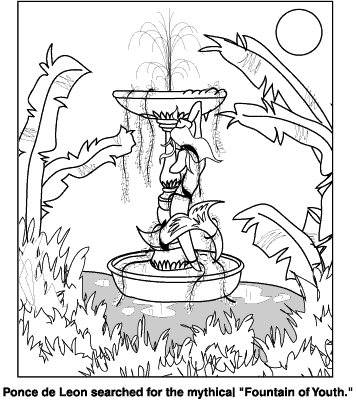| Home > Florida Then & Now > A Short History of Florida > Ponce de León | |
Ponce de León : Florida's First Spanish Explorer
Juan Ponce de León was the first Spanish explorer to arrive in Florida. Early Spanish explorers were known as conquistadors (kahn-KEYS-ta-dawrz) or "conquerors." While there are no official records, historians believe that Ponce de León was born in 1460 in San Tervas de Campos, Spain.
Early Exploration
In 1493, Ponce de León sailed with Christopher Columbus on Columbus' second voyage to the Americas. He and his family settled on an island in the Caribbean named Hispaniola (Dominican Republic). He became a military commander at this post and was appointed deputy governor.
In 1506, Ponce de León discovered a nearby island named Borinquen. While there, he found large deposits of gold. Soon after his discovery, he left the island. He returned in 1508 on orders from the king of Spain to explore and colonize the island. He renamed the island Puerto Rico. He was the island's governor for two years until the king replaced him with Columbus' son.
Discovery of Florida
Hurt by the King's action, Ponce de León sailed again, this time north through the Bahamas heading towards Florida. He was in search of new lands and treasures. He had also heard of a mythical fountain of youth. Indians spoke of a legendary, magical spring whose water was believed to make older people young again. Ponce de León explored many areas, including the Bahamas and Bimini, for both gold and the mythical fountain, but he never found either.
In late March of 1513, his ships landed on Florida's east coast near present-day St. Augustine. He claimed this beautiful land for Spain. Since he had discovered this country of lavish landscape and beautiful beaches, he was entitled to name it. He named it La Florida (LAH flow REE dah) or "place of flowers."

He decided to continue his exploration of this land and sailed down the coast. He encountered some rough currents at one point and named the area Cape Canaveral which means “Cape of Currents”.
Ponce de León continued down the east coast of Florida and along the keys until he arrived at an island that had many
turtles. He named the island Dry Tortugas because there was no fresh water on the island and “tortugas” means “turtle” in Spanish.Ponce de León and the Calusa Indians
Continuing up the west coast of Florida, Ponce de León entered the Charlotte Harbor area. As he and his men explored inland for wood and fresh water, they saw the Calusa tribal village at Mound Key. They discovered that the Calusa were an unfriendly tribe. The explorers fled back to their ships and decided to leave the area. They sailed back to Puerto Rico.
Return to Florida
In 1521, Ponce de León returned to Florida again to build a colony. He landed on the gulf beaches between Charlotte Harbor and Estero Bay with over 200 settlers, horses, tools, and seeds. The plan was to set up a farming colony. As they went inland for fresh water, the Calusa ambushed them. Ponce de León was shot in the thigh by an arrow and was seriously wounded. The settlers decided to abandon the settlement and sail back to Cuba.
As a result of his wound, Ponce de León died at the age of 61 in Cuba. He will always be remembered as the brave conquistador who first explored many parts of Florida and searched for the mythical fountain of youth.
| Home > Florida Then & Now > A Short History of Florida > Ponce de León |
Exploring
Florida: A Social Studies Resource for Students and Teachers
Produced by the Florida Center for Instructional
Technology,
College of Education, University of South Florida © 2002.